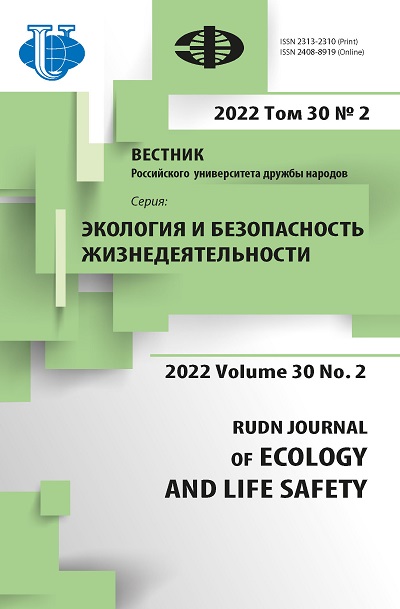Prospects for the use of surface waters of the Irkutsk region for drinking water supply and the production of soft drinks
- Authors: Dzyuvina O.I.1, Kotova T.V.2,3, Fedorova Y.S.2, Valnyukova A.S.2, Masaev V.Y.4,5
-
Affiliations:
- Branch of the Baikal State University in Ust-Ilimsk
- Kemerovo State Medical University
- Ural State University of Economics
- Kuzbass State Technical University
- Kuzbass State Agricultural Academy
- Issue: Vol 30, No 2 (2022)
- Pages: 177-188
- Section: Industrial Ecology
- URL: https://journals.rudn.ru/ecology/article/view/31437
- DOI: https://doi.org/10.22363/2313-2310-2022-30-2-177-188
Cite item
Full Text
Abstract
One of the urgent problems of modern civilization is the provision of the population with highquality drinking water. According to the World Health Organization (WHO), at least 5-10 % of the population suffers from waterborne diseases. According to the Federal Service for Supervision of Consumer Rights Protection and Human Well-being in nine cities of the Siberian Federal District, the influence of water quality on the formation of population morbidity (from 7,7 to 41,0 %) has been established. Analysis of the data presented in the State reports on the state and protection of the environment of the Irkutsk region showed that in the surface waters of the region there is a systematic excess of the maximum permissible concentration (MPC) for phenol, and in some controlled areas for chloroform. One of the main components used in the production of various non-alcoholic products is water. Various organic substances, such as phenols, petroleum products, halogenated derivatives of hydrocarbons, according to the requirements for the quality of water used for the preparation of soft drinks, should be absent. Therefore, the purpose of the study was the use of various adsorption systems for wastewater treatment in the Irkutsk region for drinking water supply and the production of soft drinks. Used the adsorption method. The studies were carried out on model aqueous solutions, both of individual substances and in their joint presence. Mathematical modeling of the sorption process under dynamic conditions has been carried out. As a result of the studies carried out, the possibility of using charcoal for wastewater treatment has been proven. Pretreatment of activated carbon with hydrochloric acid practically does not affect the adsorption of chloroform, but leads to an increase in the adsorption of phenol. Hydrochloric acid helps to remove iron ions from the pores of the sorbents. A decrease in the degree of water purification from phenol with an increase in pH leads to the suppression of adsorption. The effect of phenol and chloroform on the value of adsorption has been established. The sorption process is limited by external mass transfer. The discrepancy between the calculated and experimental output curves of phenol and chloroform sorption from individual solutions and in their joint presence is calculated.
Keywords
About the authors
Oksana I. Dzyuvina
Branch of the Baikal State University in Ust-Ilimsk
Email: chloroform@mail.ru
ORCID iD: 0000-0001-9288-1594
Candidate of Technical Sciences, Assistant Professor, Teacher of the Cycle Commission of Mechanization, Technology and Informatization
Ust-Ilimsk, RussiaTatyana V. Kotova
Kemerovo State Medical University; Ural State University of Economics
Email: t_kotova@inbox.ru
Doctor of Technical Sciences, Assistant Professor, Professor of the Department of Pharmaceutical and General Chemistry, Kemerovo State Medical University; Leading Researcher, Scientifi and Educational Center “Technologies of Innovative Development”, Ural State Economic University Kemerovo, Russia; Ekaterinburg, Russia
Yuliya S. Fedorova
Kemerovo State Medical University
Email: fedorova_yuliya_sergeevna@mail.ru
ORCID iD: 0000-0002-5543-0513
Candidate of Pharmaceutical Sciences, Assistant Professor, Associate Professor of the Department of Pharmacology
Kemerovo, RussiaAnastasia S. Valnyukova
Kemerovo State Medical University
Email: nastya711@bk.ru
ORCID iD: 0000-0002-8084-2536
Candidate of Chemical Sciences, Associate Professor of the Department of Pharmaceutical and General Chemistry
Kemerovo, RussiaVladislav Yu. Masaev
Kuzbass State Technical University; Kuzbass State Agricultural Academy
Author for correspondence.
Email: masaev-62@mail.ru
ORCID iD: 0000-0003-0709-1278
Candidate of Technical Sciences, Assistant Professor, Associate Professor of the Department of Construction of Underground Structures and Mines, Kuzbass State Technical University; Associate Professor at the Department of Landscape Architecture, Kuzbass State Agricultural Academy
Kemerovo, RussiaReferences
- Houtman CJ, Kroesbergen J, Lekkerkerker-Teunissen K, Van der Hoek JP. Human health risk assessment of the mixture of pharmaceuticals in Dutch drinking water and its sources based on frequent monitoring dataSci. Total Environ. 2014;(496):54—62.
- Borrull Josep, Colom Agustí, Fabregas Josepa, Borrull Francesc, Pocurull Eva. Presence, behavior and removal of selected organic micropollutants through drinking water treatment. Chemosphere. 2021;276:130023.
- Verliefde A, Cornelissen E, Amy G, Van der Bruggen B, Van Dijk H. Priority organic micropollutants in water sources in Flanders and the Netherlands and assessment of removal possibilities with nanofiltration. Environ. Pollut. 2007;(146):281—289.
- Kim AN, Grafova OE. Modern methods of water purification in local objects: monograph. Saint Petersburg State University of Architecture and Civil Engineering Publ. Saint Petersburg. 2016. 280 p. (In Russ.)
- Dzyuvina OI. Evaluation of the efficiency of sorption purification of drinking water from chloroform. Chemistry for sustainable development. 2008;(16):479—484. (In Russ.)
- Museev TS, Soldatov KV. Analysis of modern sorbents based on materials of organic origin. Actual problems of the humanities and natural sciences. 2017;1—1:69—73. (In Russ.)
- Dai YJ, Liu M, Li JJ, Yang SS, Sun Y, Sun QY, Wang WS, Lu L, Zhang KX, Xu JY, Zheng WL, Hu ZY, Yang YH, Gao YW, Liu ZH. A review on pollution situation and treatment methods of tetracycline in groundwater. Sep. Sci. Technol. 2020;(55):1005—1021.
- Lima L, Baêta BE L, Lima DR S, Afonso RJ CF, De Aquino SF, Libânio M. Comparison between two forms of granular activated carbon for the removal of pharmaceuticals from different waters. Environ. Technol. 2016;(37):1334—1345.
- Galimova RZ, Shaikhiev IG, Almazova GA, Sverguzova SV. Investigation of the kinetics of phenol adsorption processes by waste felt-felt production. Vestnik BGTU im. V.G. Shukhova. 2016;(10):179—184.
















